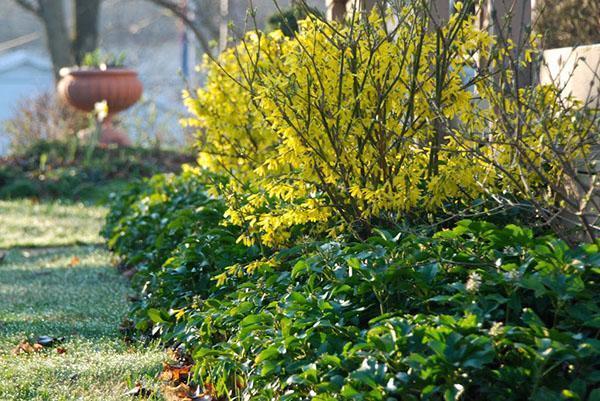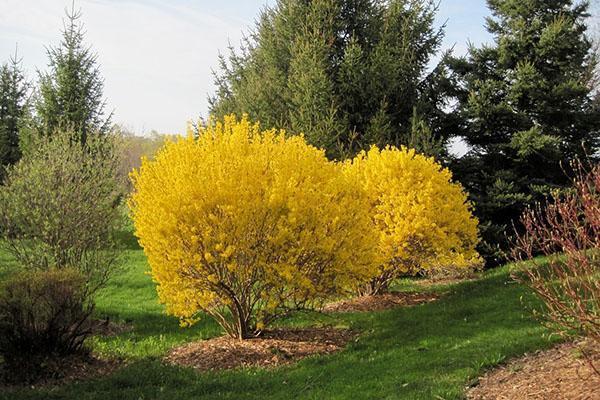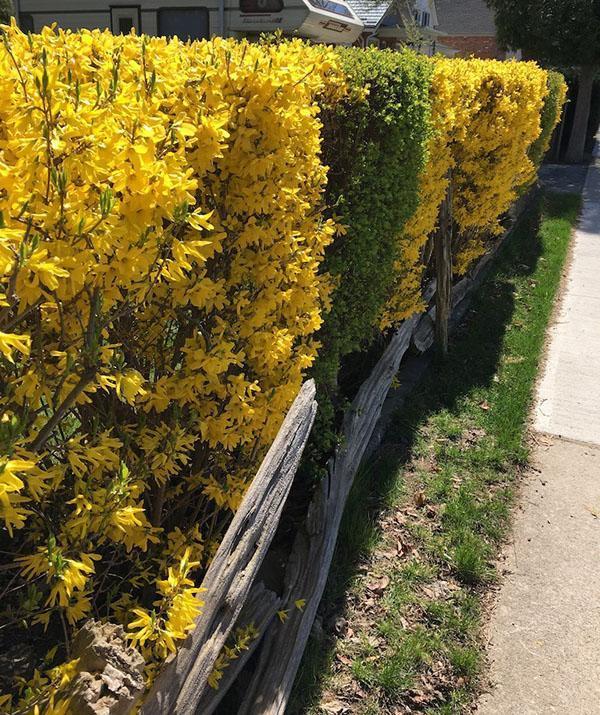The subtleties of planting and care in the open field for forsythia
 Blooming forsythia, strewn with hundreds of bright yellow flowers, is impossible to miss! If the summer resident wants to be decorated with forsythia every spring, planting and care in the open field are key stages on the path to success.
Blooming forsythia, strewn with hundreds of bright yellow flowers, is impossible to miss! If the summer resident wants to be decorated with forsythia every spring, planting and care in the open field are key stages on the path to success.
Perennial shrubs, one of the first to break the monochromaticity of early spring, came to Europe from Asia and were named after a botanist who brought the first seedlings to the Old World. Today forsythia is the most popular type for landscaping and creating hedges.
How and when to organize planting and caring for forsythia in the open field at their summer cottage? What does a shrub need for friendly growth?
Conditions for planting forsythia in the open field

Although forsythia tolerate shade, in the sun the bush forms more dense and even. The plant is undemanding to soil fertility, but it develops better on soil with an alkaline reaction, good drainage. Culture:
- undemanding to care;
- has excellent frost resistance, simplifying the wintering of forsythia in the open field;
- tolerates drought well;
- responds well to shearing and can be used for growing hedges.
 There are two options for planting forsythia in the ground: in spring and autumn. In the first case, young shrubs, after acclimatization, immediately begin to grow, giving new shoots. Bushes transferred to the garden in autumn only take root, and begin to grow after wintering.
There are two options for planting forsythia in the ground: in spring and autumn. In the first case, young shrubs, after acclimatization, immediately begin to grow, giving new shoots. Bushes transferred to the garden in autumn only take root, and begin to grow after wintering.
The timing of planting forsythia in the ground
The time for transferring seedlings to the garden is chosen depending on the region and the quality of the planting material. Many nurseries today offer young plants with a closed root system. Seedlings grown in containers are transplanted together with an earthen clod, so the roots do not suffer, the bush easily and quickly adapts to a new place of residence. And the summer resident is guaranteed easy care for forsythia in the open field after planting, whenever it happens: in spring, summer or autumn.
For seedlings with an open root system, it is better to plant in the spring months, when the threat of sudden frosts goes away, or in the fall, about a month before the onset of seasonal cold weather. During this period of time, the shrub will acclimate and be able to prepare for winter.
 Since the climatic conditions in the regions of the country are seriously different, there is a significant difference in the timing of planting and caring for forsythia in the open field, in the Moscow region and, for example, in central and northern Siberia, where the heat comes later, and the summer is much shorter:
Since the climatic conditions in the regions of the country are seriously different, there is a significant difference in the timing of planting and caring for forsythia in the open field, in the Moscow region and, for example, in central and northern Siberia, where the heat comes later, and the summer is much shorter:
- If you delay planting plants in the garden, their adaptation and rooting will be delayed, and the shoots that have dedicated over the summer will not have time to get stronger before the onset of frost.
- Early spring planting threatens with the danger of freezing of the buds, tops of the shoots, and in case of severe frosts on the soil, damage to the growth points and roots.
 In autumn, planting forsythia in the ground also depends on weather and climatic conditions and can vary even within the same region, for example, as large as the Urals.If in the south gardeners live according to a calendar similar to that used by summer residents of the middle lane, then in the north the weather is much more severe and changeable.
In autumn, planting forsythia in the ground also depends on weather and climatic conditions and can vary even within the same region, for example, as large as the Urals.If in the south gardeners live according to a calendar similar to that used by summer residents of the middle lane, then in the north the weather is much more severe and changeable.
Planting forsythia in open ground
 Forsythia prefer dry, drained soil and do not tolerate stagnant moisture in the soil. Therefore, at the bottom of the planting pits 60 cm deep and 50 cm wide, a powerful drainage is made from broken brick, expanded clay or gravel. It is especially important not to neglect this measure in areas with dense soil that retains water and where the groundwater is too close. An example is planting and caring for forsythia in the Leningrad region.
Forsythia prefer dry, drained soil and do not tolerate stagnant moisture in the soil. Therefore, at the bottom of the planting pits 60 cm deep and 50 cm wide, a powerful drainage is made from broken brick, expanded clay or gravel. It is especially important not to neglect this measure in areas with dense soil that retains water and where the groundwater is too close. An example is planting and caring for forsythia in the Leningrad region.
A layer of sand and a prepared soil mixture based on:
- 2 pieces of leafy land;
- 1 part peat;
- 1 part sand.
 For each hole, 200 grams of sifted wood ash is mixed into the ground. The substrate is poured with a mound, on the sides of which the roots of the bush are spread. After filling the hole, the soil is compacted and watered abundantly at the rate of 10-15 liters per plant. In the fall, after planting forsythia, caring for the shrub consists of dense mulching trunk circle. This will help conserve water in the soil and protect the roots from hypothermia.
For each hole, 200 grams of sifted wood ash is mixed into the ground. The substrate is poured with a mound, on the sides of which the roots of the bush are spread. After filling the hole, the soil is compacted and watered abundantly at the rate of 10-15 liters per plant. In the fall, after planting forsythia, caring for the shrub consists of dense mulching trunk circle. This will help conserve water in the soil and protect the roots from hypothermia.
Mulch will help in spring, especially where summer comes quickly, and the soil dries quickly, covered with a dense impenetrable crust.
Caring for forsythia after planting in the open field
 An important advantage of forsythia is its undemanding nature and the absence of any special care. During the warm season shrubsthat grow rapidly with minimal care need:
An important advantage of forsythia is its undemanding nature and the absence of any special care. During the warm season shrubsthat grow rapidly with minimal care need:
- in irrigation, if there is no natural precipitation, and the soil under the plants is completely dry;
- in maintaining the cleanliness and looseness of the trunk circles;
- in a triple feeding;
- in a haircut that helps maintain the health and shape of the crown.
In hot dry times, the plants are watered abundantly once or twice a month, the field of which is loosened, weeded and mulched. Lowland peat mixed with humus and wood ash can be used as mulch. This composition protects the roots from overheating and is an excellent long-acting fertilizer. In addition, shrubs respond well to the introduction of full mineral fertilizers before and after flowering.
In the second half of summer, you should not fertilize shrubs with nitrogen. It will cause active growth of young shoots, which, even with proper planting and caring for forsythia in the Urals, Siberia and in the middle lane, will not have time to mature and will die with the onset of frost.
An important part of caring for forsythia is pruning the shrub. For sanitary purposes, the removal of dead, old or damaged branches is carried out in the spring, and a haircut to maintain shape - in early summer, when the mass flowering ends. Until recently, shoots yellow from flowers can be shortened by half the length, and old branches are cut above the ground so that several buds remain at the base.
Once every 3 to 4 years, forsythia is rejuvenated by evenly cutting all shoots by half or two-thirds of the length. Over the summer, the plant will restore the crown, which will be dense, uniform and young, so that next spring it will please with a friendly bright flowering.
In most regions, the plant winters excellently without shelter. If the winters have little snow, before wintering, forsythia in the open field is gently tilted to the ground, fixed and covered with spruce branches or dense non-woven material. At the first opportunity, the bushes are covered with snow.
Reproduction of forsythia in the open field
 The remaining parts of the branches after pruning are an excellent material for obtaining cuttings that will serve for the propagation of forsythia. Green shoots are cut into pieces 10-15 cm long so that each one has several healthy buds. The lower leaves are cut off, and the resulting stalk, after treatment with a rooting stimulant, is planted in a greenhouse.
The remaining parts of the branches after pruning are an excellent material for obtaining cuttings that will serve for the propagation of forsythia. Green shoots are cut into pieces 10-15 cm long so that each one has several healthy buds. The lower leaves are cut off, and the resulting stalk, after treatment with a rooting stimulant, is planted in a greenhouse.
 In autumn, another method of breeding forsythia in the open field is possible.Lignified cuttings are planted in a school, organized in a quiet place protected from wind and flooding. For the time remaining before the cold weather, the seedling will give roots, and 2-3 buds left above the soil surface will wake up in the spring and form a young crown of a dwarf shrub. These plants can be planted in a permanent place next fall.
In autumn, another method of breeding forsythia in the open field is possible.Lignified cuttings are planted in a school, organized in a quiet place protected from wind and flooding. For the time remaining before the cold weather, the seedling will give roots, and 2-3 buds left above the soil surface will wake up in the spring and form a young crown of a dwarf shrub. These plants can be planted in a permanent place next fall.